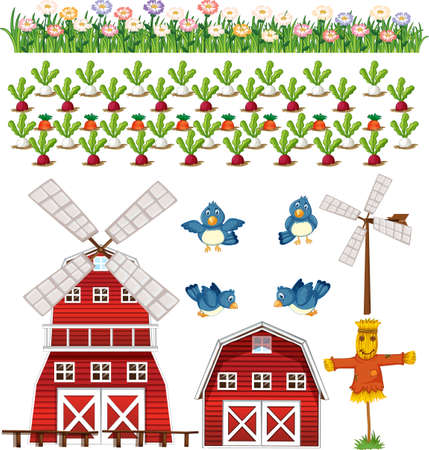Introduction to Polytunnels and Glasshouses
When it comes to horticultural structures in the UK, polytunnels and glasshouses are two of the most prevalent choices for both commercial growers and enthusiastic gardeners. These structures serve a similar purpose: providing a controlled environment to extend growing seasons, protect crops from unpredictable British weather, and improve yields. However, their structural designs, materials, and long-term performance differ significantly. In the UK, where rainfall, wind, and temperature fluctuations are the norm rather than the exception, understanding these differences is crucial. This article aims to provide an in-depth comparison of polytunnels and glasshouses, focusing specifically on how their structural characteristics impact durability and maintenance under typical British weather conditions. By examining these aspects, we hope to offer practical insights for anyone considering investment in either type of structure, whether for small-scale gardening or larger agricultural operations.
2. Materials and Construction Techniques
When examining the structural differences between polytunnels and glasshouses within the context of British weather, it is essential to consider both the materials used and the construction techniques employed for each structure. These factors directly influence durability, maintenance requirements, and ultimately, suitability for local climatic challenges such as high winds, heavy rainfall, and occasional snowfall.
Common Materials Used
| Aspect | Polytunnels | Glasshouses |
|---|---|---|
| Main Structure | Galvanised steel or aluminium hoops | Aluminium or timber frames |
| Cladding/Covering | UV-stabilised polyethylene film (single or double layer) | Toughened glass panels (sometimes polycarbonate sheets) |
| Foundation | Ground anchors or base plates on compacted soil/concrete | Concrete footings or dwarf brick walls |
Construction Approaches in the British Context
The typical construction approach for polytunnels is designed around flexibility and speed. Their lightweight, modular frames are often assembled directly on-site with minimal foundations, allowing for quick installation even in remote or uneven terrain commonly found across rural Britain. The polyethylene covering is stretched over the frame and tightly secured, creating a semi-permanent but easily replaceable weather barrier.
In contrast, glasshouses demand a more permanent foundation. The use of aluminium or timber framing paired with robust glazing (often toughened for safety) means that glasshouse construction is more labour-intensive and requires precise alignment to ensure weather-tightness. In Britain, it is not uncommon to see traditional glasshouses built on dwarf brick walls—a nod to both aesthetic preferences and the need for added insulation at ground level to counteract damp and cold.
Comparative Table: Key Features
| Feature | Polytunnel Approach | Glasshouse Approach |
|---|---|---|
| Installation Time | Quick (days) | Lengthy (weeks/months) |
| Adaptability to Site | High—can be erected on uneven ground | Moderate—best on levelled sites |
| Lifespan of Cover/Glazing | 5–8 years (polyethylene film) | 20+ years (glass panels) |
British Weather Considerations
The British climate demands resilience from structures due to its variability. Polytunnels’ flexible frames can bend under wind loads, reducing the risk of catastrophic failure but sometimes necessitating more frequent repairs or cover replacements after storms. Glasshouses offer better long-term resistance but require sturdier foundations to withstand wind uplift and prevent glass breakage during hail or gales. Overall, these material and construction choices reflect a balance between cost-effectiveness, speed of deployment, longevity, and the unique weather patterns experienced across the UK.
![]()
3. Durability under British Weather Conditions
When considering the durability of polytunnels and glasshouses, it is essential to analyse how each structure copes with the notoriously unpredictable British weather. The UK climate presents a unique set of challenges—frequent rainfall, gusty winds, occasional frost, and persistent dampness all take their toll on garden structures over time.
Polytunnels, typically constructed with steel frames and covered in polyethylene sheeting, are known for their flexibility and resilience in moderate weather. Their rounded shape allows wind to pass over with less resistance, reducing the risk of structural damage in strong gales. However, severe storms can still pose a threat, particularly if the tunnel is not securely anchored. Heavy rain can pool on the cover if not adequately tensioned, potentially leading to tears or sagging. Prolonged exposure to UV rays may also degrade the plastic over several years, necessitating periodic replacement of the sheeting.
In contrast, glasshouses—often built from aluminium or timber frames with glass panels—offer robust protection against rain and frost. The rigidity of their structure generally withstands persistent downpours and shields plants from hail and freezing temperatures more effectively than polytunnels. Nevertheless, glass panels are susceptible to breakage during high winds or impact from falling branches—a common issue in blustery British winters. Timber frames require regular maintenance to prevent rot due to moisture ingress, while metal frames can corrode without proper treatment.
Ultimately, both polytunnels and glasshouses must contend with condensation issues caused by fluctuating temperatures and high humidity levels prevalent across much of the UK. Proper ventilation and routine checks are vital for maintaining internal conditions and prolonging structural life. In summary, while polytunnels offer greater flexibility and easier repair after storm damage, glasshouses provide superior long-term stability but demand more meticulous upkeep in response to the British climate’s many quirks.
4. Maintenance Requirements and Longevity
When considering the upkeep and expected lifespan of polytunnels versus glasshouses in the UK, it is crucial to weigh the impact of weather, material resilience, and maintenance cycles. Both structures require regular attention, but their needs and vulnerabilities differ significantly due to their construction materials and design.
Routine Upkeep
Polytunnels demand frequent inspections, particularly after storms or periods of high wind. The polythene cover can be prone to rips or becoming loose, so securing fixings and patching small tears promptly is a routine part of ownership. Cleaning is relatively straightforward, typically involving mild soap and water to prevent algae build-up.
Glasshouses, on the other hand, benefit from less frequent but more meticulous cleaning to maintain light transmission through glass panels. Guttering should be cleared regularly, and hinges or frames may need oiling or repainting to prevent rust or decay—especially important in damp British conditions.
Repair Cycles and Common Issues
| Polytunnels | Glasshouses | |
|---|---|---|
| Common Repairs | Patching tears, tightening covers, replacing polythene sheets | Replacing broken panes, sealing leaks, treating metal/wood for corrosion or rot |
| Weather Vulnerability | Susceptible to wind damage and UV degradation over time | Risk of shattered glass in hail; wooden frames susceptible to rot without treatment |
| Frequency of Major Repairs | Every 4-6 years (polythene replacement) | Panes as needed; frame maintenance every 5-10 years depending on material |
Expected Lifespan in British Conditions
The longevity of both structures is heavily influenced by local weather patterns. In milder regions, both may last longer with diligent care. However, typical lifespans are as follows:
- Polytunnels: Polythene covers generally last 4-6 years before requiring replacement. The metal frame itself can endure for 15 years or more with minimal rust if well-maintained.
- Glasshouses: A quality aluminium-framed glasshouse can easily surpass 30 years with consistent care. Wooden frames may require more intervention but can also last decades if protected from moisture.
A Practical Perspective for British Growers
The cost-effectiveness of polytunnels comes at the price of more frequent cover replacements and ongoing minor repairs—manageable with basic DIY skills. Glasshouses, while more robust against daily wear-and-tear, require investment in glazing repairs and periodic frame treatments but reward with superior longevity and lower day-to-day maintenance. In summary, choosing between these structures involves balancing upfront costs against long-term upkeep—a decision often shaped by local climate and one’s willingness to tackle regular maintenance tasks.
5. Cost Implications and Practical Considerations
When deciding between polytunnels and glasshouses, UK growers must carefully weigh the total cost of ownership, ongoing maintenance, insurance, and daily operational challenges associated with each structure. While upfront costs are typically lower for polytunnels, especially for small- to medium-sized installations, the picture changes when factoring in long-term expenses and resilience against the British climate.
Initial Investment vs. Lifetime Value
Polytunnels generally require less capital outlay compared to glasshouses, making them attractive for those starting out or expanding incrementally. However, their coverings—usually polyethylene—tend to degrade under UV light and can be susceptible to storm damage, meaning replacement every 3–7 years is common. In contrast, glasshouses have a much higher initial price tag due to the cost of glass and a robust supporting frame, but their materials can last decades with appropriate care.
Insurance Considerations
Insurance premiums are another key factor. Polytunnels may attract higher premiums or more exclusions due to their vulnerability to wind and snow loads, which are increasingly relevant given unpredictable British weather patterns. Glasshouses, being sturdier and often built to more rigorous standards, may enjoy more favourable terms. It’s advisable to consult insurers familiar with horticultural risks in the UK to ensure adequate cover.
Everyday Maintenance and Hidden Costs
Routine maintenance also differs notably. Polytunnels often require regular tensioning of plastic covers, patching of tears, and vigilance against condensation-related mould. Glasshouses need periodic cleaning to maximise light transmission and prevent algae buildup, as well as attention to seals and structural integrity after heavy storms. For both types, guttering should be kept clear to manage rainfall efficiently—a non-negotiable given Britain’s frequent downpours.
Practical Advice for UK Growers
Ultimately, consider not just how much you can afford upfront but what you’re prepared to handle over time—both financially and in terms of labour. For sites exposed to high winds or where access for repairs is tricky, investing in a robust glasshouse may provide peace of mind and lower your total cost of ownership in the long run. Conversely, if flexibility and rapid installation are priorities, polytunnels offer unmatched value but demand a proactive approach to maintenance and weatherproofing. Assess your risk tolerance honestly: while polytunnels are forgiving on budgets, glasshouses reward patience and planning with greater durability through Britain’s ever-changing seasons.
6. Environmental Impact and Sustainability
When considering the structural differences between polytunnels and glasshouses in the context of British weather, it is essential to assess their respective environmental footprints. Both structures play a key role in UK horticulture, but their sustainability profiles differ in terms of materials, energy use, and long-term environmental impact.
Material Considerations
Polytunnels are typically constructed using steel frames covered with polyethylene sheeting. This plastic covering has a relatively short lifespan—often around five years—necessitating frequent replacement and contributing to plastic waste. However, recent advances have introduced more recyclable plastics and biodegradable films to address these concerns. In contrast, glasshouses use aluminium or steel frames with glass panels. While glass production is energy-intensive, these panels can last for decades if well-maintained, reducing replacement frequency and waste generation.
Energy Use and Insulation
The thermal properties of these structures significantly affect their sustainability. Glasshouses generally offer superior insulation compared to polytunnels, which can help reduce heating requirements during colder British months. However, polytunnels warm up more quickly under sunlight but lose heat rapidly at night, leading to greater temperature fluctuations and potentially higher overall energy input for climate control.
Water Management
Both systems require efficient water management to support plant health and conserve resources. Rainwater harvesting is commonly integrated into both designs in the UK, though glasshouses often facilitate more effective collection due to their rigid roof structures. Polytunnels may require additional guttering solutions to achieve similar efficiency.
Embodied Carbon and Longevity
The embodied carbon—the total greenhouse gas emissions produced during manufacture—differs notably between the two structures. Glasshouses have higher embodied carbon due to energy-intensive glass production but compensate through longer service life and reduced material turnover. Polytunnels have a lower initial footprint but require regular replacement of coverings, which accumulates over time.
Alignment with British Sustainability Priorities
UK policy increasingly prioritises resource efficiency, waste reduction, and renewable energy use. Glasshouses align well with these goals when equipped with modern glazing technologies and renewable energy sources, such as solar panels or ground-source heat pumps. Conversely, polytunnels are valued for their lower upfront costs and rapid installation but face scrutiny over plastic waste unless recycling schemes are employed.
Ultimately, the choice between polytunnels and glasshouses involves balancing immediate economic considerations with long-term environmental responsibility. For growers committed to minimising their ecological footprint in line with British sustainability priorities, investing in robust maintenance regimes, recycling initiatives, and renewable energy integration is vital—regardless of the structure chosen.
7. Conclusion
In summary, the structural differences between polytunnels and glasshouses significantly influence their durability and maintenance requirements, particularly in the context of unpredictable British weather. Polytunnels offer a flexible, cost-effective solution that copes well with mild to moderate wind and rain, though they typically require more regular maintenance due to their plastic covering and lighter framework. Glasshouses, on the other hand, provide robust, long-lasting protection with superior insulation and light transmission, but their higher initial investment and susceptibility to breakage in extreme weather must be considered. For British gardeners and farmers, the choice largely depends on budget, crop type, and location. Those seeking an affordable and easily adaptable option may find polytunnels preferable, especially for seasonal growing or smaller plots. Conversely, for those prioritising longevity, aesthetics, and year-round cultivation—particularly in areas exposed to harsher elements—a glasshouse is likely the better investment. Ultimately, understanding these key structural differences ensures growers can make an informed decision suited to both their horticultural goals and the realities of the British climate.


